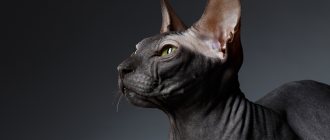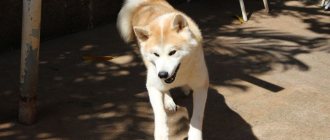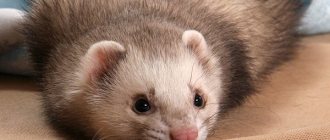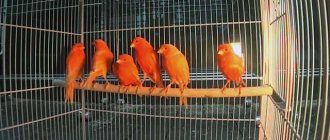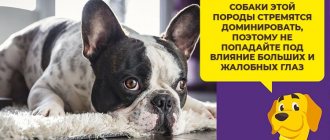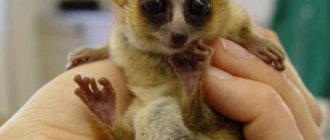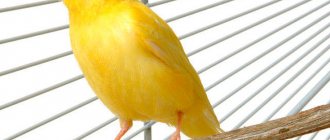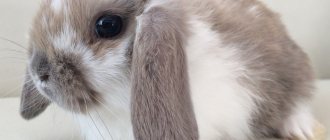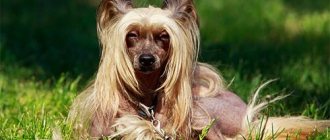Video
* We invite you to watch a video about the Canadian Sphynx . In fact, in front of you is a playlist in which you can select and watch any of 20 videos about a given cat breed by simply clicking on the button in the upper right corner of the window. In addition, the material contains quite a lot of photos. By looking at them you can find out what the Canadian Sphynx looks like.
In this article:
|
Rate the material!
[Total votes: 0 Average: 0]
The Canadian Sphynx is a rather unusual cat. When you see these creatures, you get the impression that they came to us from another planet. They are called figurine cats. Sphinxes are very similar to people; they like to sleep under a blanket, with their heads on the pillow, and do not look away for a long time, which is not typical for other animals.
Rules for caring for claws
The reason for the increased contamination of claws is the lack of fur in Canadian Sphynx cats. In this regard, as in the ears, a mud deposit is formed, consisting of dust and skin secretions, which leads to layering and thickening of the animal’s claws.
To avoid this, there are a number of rules that you can follow to achieve good results:
- It is better to start pruning work after water procedures.
- To begin with, hold the animal well to avoid slipping out at the most crucial moment.
- Trimming should be done with regular pliers, never touching the soft flesh under the claws.
- After this, you need to dull the tips of the claws with a woman's nail file.
- Do not allow claw amputation under any circumstances! This will lead to poor coordination and irritability in your pet.
History of the origin of the Canadian Sphynx
Unlike other hairless cats, this breed is the only one that has received worldwide recognition. For more than 50 years, sphinxes have been passing on their characteristics in a recessive manner. The other two varieties are only on the path of formation. The first mentions of hairless cats date back to antiquity. Presumably, the owners of the breed were also the Aztecs.
Representatives of this species were nicknamed Mexican hairless and at the end of the 20th century they were actively represented at exhibitions. However, the last pair disappeared in the early 1930s, leaving no legacy. In this regard, the continuation of the family ended. The origin of the species remains unknown.
Interesting fact: The Mexican Hairless had a long body, amber eyes, and excessively long whiskers, which the Canadian Sphynx does not have. By winter, such individuals grew long fluffy hair on their backs and tails, which quickly fell out in the spring. Scientists consider the breed to be related to the Don Sphynx due to its long mustache.
At some point, hairless babies began to appear in all corners of the planet. However, no one has attempted to cross bald creatures with each other. So it is difficult to say whether the Sphynx turned out to be a descendant of these individuals, or whether this happened in 1966 in Canada, when a mutation provoked the birth of a hairless kitten from furry parents.
The baby was named Prune. Soon he was crossed with his own mother and the kittens, surprisingly, were also born without fur. To preserve the Prune gene, it was crossed with daughters and granddaughters. The first representative of the breed lived 28 years. It turned out that the babies needed special care and many died after birth.
A few years later, the short-haired cat gave birth to a hairless kitten, who was nicknamed Epidermis. A year later, by coincidence, a hairless baby was born in the same city and they ended up in the same nursery. It was here that this couple became the founders of a new elite breed.
Choosing a Sphynx kitten
It is better to look for a kitten in a nursery or from breeders with a good reputation. You should not buy a baby on the market - there is a high risk of purchasing a sick animal or a cross of dubious blood. Carefully check the baby's pedigree. During your visit, ensure that the animals are kept clean. Kittens must be healthy, well-groomed and playful. A kitten should be taken away from its mother no earlier than three months of age.
The list of documents issued by the breeder when purchasing a kitten includes:
- birth certificate;
- pedigree or metric;
- veterinary passport;
- club card.
You can distinguish Sphynx kittens from Don or Peterbald kittens by the following characteristics:
- physique - “Canadians” are slender, but muscular, with a broad chest and bulging belly. Donchaks are massive, with a wide body, and Peterbalds are graceful, with long thin paws;
- the head of the “Canadians” is shorter and wider than that of the Donetsk and Peterbalds;
- Donchak's ears are narrower than those of "Canadians", and Peterbalds' ears are more spread apart;
- “Canadians” have wide eyes, Donetsk and Peterbalds have almond-shaped eyes.
Distinguishing representatives of the three breeds from each other is not as difficult as it might seem.
Depending on the class of the kitten and its parents, the price can range from 10 to 50 thousand rubles.
Canadian Sphynx - description of the breed
The appearance of pets creates the impression of majestic, graceful creatures. The breed is considered decorative. Its main feature is the absence of hair on its muscular body. They have a soft fluff that feels like velor. The creatures reach average sizes weighing from 3 to 5 kilograms.
There is a slight curvature on the paws, the toes are long, with large pads. When cats walk, it looks like they are walking in heels. They do this elegantly, with a beautiful gait. Fit physique, neat proportions. The head has large ears and large eyes. The tail is long, tapering towards the end.
There are translucent hairs on the paws, bridge of the nose, tail and ears. The greatest number of them is on the muzzle, in the area of the ears and neck. Other areas have fluff or lack of vegetation. The skin is thick, elastic, folded. Babies are born completely wrinkled and remain in this state for up to a month. There are either no mustaches at all, or they are very short.
In newborn kittens, the ears remain drooping until 3 weeks of life. The larger they grow, the later they will rise. There is no hair inside the ear. The chest is wide, the belly is round, as if the cat had just eaten. There may be a tassel at the tip of the tail. The skin pigment is pronounced, so the color is easy to distinguish. The skin is very warm to the touch.
The lemon-shaped eyes give the animals a unique expression as well as an alien appearance. The distance between them can exceed the size of the eyes themselves. The lack of fur has given rise to the myth that Sphynx cats are suitable for allergy sufferers. However, this is not true, since the disease manifests itself in the proteins in the creatures’ saliva and in the sebaceous glands.
Despite their strong build, Canadians are considered fragile creatures. The nose is straight. The breed standard requires the presence of a pronounced dimple between the forehead and nose. Eye color usually harmonizes with skin color. The neck is of medium length. The front paws have a wide set.
Description of the breed
Sphynx standard
The description of a purebred Canadian Sphynx includes the following parameters:
| Options | Characteristic |
| Head | Wedge-shaped, with clearly defined cheekbones and a hollow from the forehead to the nose. Strong chin. Pronounced pads in the area where the mustache is located. |
| Ears | Large, erect, widened towards the base, with rounded tips. Kittens are born with floppy ears and stand up by 3 weeks. |
| Eyes | Large, shaped like a lemon. Any iris color. |
| Body | Medium length, muscular. The belly is rounded. |
| Legs | Medium size, hind legs longer than front ones. Paws are oval, with developed toes. |
| Tail | Thin, flexible, long. Can be rolled into a ring. |
| Leather and wool | Smooth, covered with fine hairs on the tip of the tail, the outside of the ears and on the paws. The body may be covered with short (2 mm) fluff. The skin resembles suede. Completely hairless animals have elastic skin. According to the nature of hair growth, they are divided into types: naked (hair and whiskers are absent, the body is in folds), flock (thin microhairs up to 0.1 cm, with maturity they can become hairless), velor (hairs 0.2–0.4 cm, hair is sphinx velor may not be present on the entire body), brush (hairs up to 0.5 cm, brush sphinx hair is straight or curled, hard). |
| Mustache | Short, winding. Sometimes they are completely absent. |
Colors
The classification of sphinxes is based on skin pigmentation:
- Solid. Plain. The nose matches the color, the paw pads match the pigmentation color or are pink. Colors: white, cream, lilac, blue, fawn, cinnamon, red, chocolate, black.
- Tortoiseshell. Characteristic of females. In males it is recognized as a deviation. Two-color pigmentation: in the classic version - black and red; in clarified - blue and cream. Options: blue tortoise, black, lilac, chocolate tortoise, tortoiseshell cinnamon, tortoiseshell fawn.
- Tabby. Dark spots on the back, tail and paws. The nose and paw pads are pigmented or pinkish. Color types: spotted - pigmentation in the form of spots, marbled - spots in the form of patterns on marble, brindle/mackerel - spots in the form of horizontal stripes.
- Bicolor. Basic color (solid, tortoiseshell, tabby) combined with white. The colored part is clearly separated from the white. One ear is colored. Nose and paw pads match the base color.
- Color-point. Color like Siamese cats - light body and dark tips of the ears, nose, paws, tail. The paw pads and nose match the color of the point. Color options: seal point, chocolate point, blue point; lilac point, cream point.
Differences between the Canadian, Don and St. Petersburg sphinxes
The Canadian Sphynx is the first breed of hairless cat to gain worldwide recognition. Later, two more varieties were bred in Russia: the Don Sphynx and the Peterbald. They differ from Canadians genetically and externally.
In Canadians, the recessive hr gene is responsible for hairlessness. It is active if the offspring are obtained from two representatives of the breed. If you cross a Sphynx with a regular cat, the offspring will be hairy. The genetics of Peterbalds and the Don Sphynx are based on a dominant gene. They cannot be crossed with Canadians.
These types also differ in external parameters. Peterbalds and Donets have a more elongated, dense body. The skin of adult cats is absolutely smooth. Kittens can be born with fur, which then falls out on its own.
One of the most pronounced differences is the shape of the head. The Don Sphynx has a wedge-shaped skull with a hard, blunt chin. Short profile. Peterbalds are distinguished by a triangular-shaped skull and a distinctly elongated profile with a clear line connecting the tip of the nose and the chin.
Popular colors of Canadian Sphynx cats
There are many different colors of animals of this breed. The letters n, a, b in the pedigree indicate a code entry for a single color.
They are deciphered as:
- N - black. Slate gray skin, black paw pads, black nose;
- A - blue. Smooth color with a silver tint. The pads are brown, the nose is gray;
- B - chocolate. Shades vary from chocolate milk to dark chocolate. The paw pads are beige or pink, the nose is in harmony with the color;
- C - lilac. The skin color is a combination of silver and pink shades. Nose and pads pink or lilac;
- D - red. Shades from red, red to pink. The pads are brick or pink;
- E - cream. The color is pink, as are the nose pads;
- W - white. Colors range from white to pink, without spots. The pads, eyelids and nose are pale pink.
The tortoiseshell color can only be present in females. In males, the presence of this color indicates a genetic deviation. Such animals have an XXY set of chromosomes, instead of the normal XY. They usually lack the ability to reproduce.
Bicolor colors are a combination of 1/3 or 1/2 colored part to white. One ear must be colored; a colored spot on the head is welcome. The tail is colored, a white tip is allowed.
Other color combinations include:
- Van is a practically white body with no more than 3 spots on the body. The pads and nose are pink;
- Harlequin is a cross between bicolor and van. There should be a spot on the head that touches the ear. Colored tail, several spots on body and legs;
- White spotting - white clearly borders on the colored color. White should be no more than 10%. The marks are 1-2 centimeters in size.
Colorpoint, also called Siamese color. All babies of this type are born white. However, after a few days, the nose, tail, edges of the ears and paws turn cream, dark brown, golden brown, and black-brown.
Origin story
In 1966, a domestic cat gave birth to a hairless kitten in Toronto, Canada. This, as it turned out, was a natural mutation and as a result the Sphinx appeared - as we now know it. This cat and several other naturally hairless cats have been found all over the world.
They were miraculously produced by Mother Nature and formed the foundation for the development of this unusual breed. For more than thirty years, cat breeders in Europe and America have crossed Sphynks with other non-hairless cats (usually Devon Rex) and then again with hairless cats.
The goal of this breeding effort was to create a genetically strong cat with great hybrid potential. This is a very healthy breed and is not prone to health problems like some other “high-pedigree” cats.
Description of the breed
| Breed name: | Canadian Sphynx |
| Country of origin: | Canada |
| Time of origin of the breed: | 1966 |
| Weight: | 3 – 6 kg |
| EMS code: | SPH |
| Lifespan: | 14 – 16 years old |
| Price of kittens: | 100 – 1500 $ |
| The most popular nicknames: | list of nicknames for sphinxes |
These hairless cats owe their majestic appearance, first of all, to genetics (we will talk about genetics in detail below). The behavioral features of these cats, as well as their amazing manner of looking a person straight in the eyes, seem to be manifestations of real, true natural magnetism.
The Canadian Sphynx breed is today recognized throughout the world. It has been stable for more than forty years and successfully transmits its characteristics according to the recessive type.
The breed has some specific characteristics, so before purchasing a Sphynx you need to carefully weigh the pros and cons, and make a decision only after talking with specialists and first getting to know these animals.
The sphinxes seem to be looking at us from obelisks and ancient tablets that we inherited from the great and powerful Ancient Egyptian civilization. They are not at all like cats of other breeds. Exotic, mysterious, incredible energy and unique character. If you see a hairless animal, this does not mean at all that it is a Canadian Sphynx.
There is a whole list of approved criteria by which general standards for the Canadian Sphynx breed are established (we will discuss them below). Yes, you can see a hairless cat with big ears and conclude that it is 100% Sphynx. But you may be mistaken if you are guided only by these signs.
If we describe these cats briefly, we get the following: the Canadian Sphynx has very soft outlines of the lines of the body, the obligatory absence of straight, angular lines in the figure, all forms must be convex and rounded, each line smoothly transitions into another, the tail is very flexible and smoothly curved , rolled into a bagel.
Breed standard - appearance
Representatives of this breed may have the following colors:
- Black - Slate gray skin, paw pads, as well as nose are colored the same color as the skin.
- Chocolate - Chocolate color can vary from a subtle milk chocolate shade to a dark chocolate shade. In this case, the paw pads can be either pink or light brown.
- Lilac - This color gives the Sphynx's skin a silvery-pink tint. The nose and pads are painted lilac-pink or lavender.
- Red - there are newborn Sphynx kittens with a red (red) color. These kittens may have stripes and spots on their bodies. However, as the kitten gets older, these stripes and spots disappear. In adulthood, the color becomes pinkish. Sometimes there is a bright red tint. The paw pads and nose are bright pink or brick red.
- Blue-eyed white - these representatives of the breed have a uniform white color with the addition of pink. Paw pads, eyelids and nose may be pale pink. There are white sphinxes, but only with copper or dark orange eyes. Tortoiseshell - It is worth noting that only female Sphynx cats can be tortoiseshell. There are black, blue, lilac-cream and chocolate. What is the tortoiseshell color? This is a combination of spots on the body of the sphinx of two shades.
- Tabby - Sphinx of this color can be either spotted-striped or simply striped. This color is also called marbled. The predominant shades for this color are: black, blue, brown.
- Bicolor - The bicolor color in Canadians is manifested primarily in a combination of white and the main color - tabby, tortoiseshell and solid. There must be a clear distinction of color - the color of one ear and tail, a colored spot on the head. The tip of the tail may also be white.
- Color point - Canadian Sphynx cats sometimes have several variants of the color point color, or as it is otherwise called - Siamese. There should be a combination of the main color with the darker color of the paws, tail, edges of the ears and tip of the nose.
- This breed also comes in very rare colors, such as mink and sepia (sable).
Character and habits of the Canadian Sphynx
Animals are called aliens not only for their unusual appearance, but also for their temperament. There is a widespread belief that sphinxes combine the habits of a cat, a dog, a monkey and a child. The creatures are very fond of acrobatic tricks, they are playful and active, like children. Loyal as dogs.
Let's make a reservation that this is only in theory. In fact, many owners do not observe not only canine traits in their charges, but sometimes they also do not notice cat habits. Often the relationship between the owner and the pet is built only on the feeding process.
Interesting fact: Often in descriptions of the breed’s character one can find lines such as “the tenderness and affection of these cats is due only to the desire to bask in the warmth of their owner.” In fact, smart and energetic pets are friendly to the owner and guests.
Cute and loyal animals, they love to be the center of attention. When preparing the owner for bed, they climb under the blanket in search of warmth. At other times, they follow the owner everywhere, joyfully wagging their tail and enjoying communication with him.
If you haven't seen your pet for a long time, check the top shelves of the cabinets, because, like all cats, Sphynx cats love to hide. Curious animals grab and play with small objects with their tenacious paws. To satisfy their curiosity, the creatures will squeeze into any crack and turn everything upside down.
Pets do not tolerate loneliness well, so leaving them alone all day is not recommended. A distinctive feature of animals is their lack of rancor. They will never try to take revenge because of an accidental offense. The absence of jealousy allows you to keep a Sphynx at home with other pets.
Interesting facts about the Canadian Sphynx
The body temperature of cats of this breed is 4 degrees higher than that of their relatives. Due to the lack of wool and hard guard hairs, nothing warms the animals, and nature itself took care of this. This is why naked purrs seem so hot. Also, with their furry counterparts, some of the heat goes into their fur, so it seems that they are cooler.
The absence of vegetation completely reveals all the imperfections of the body. Excess or lack of weight is visually clearly visible. This condition is strictly assessed at shows, so the owner of the Canadian needs to carefully monitor his diet.
The color of a kitten is determined only by the color of the parents. Other individuals from the pedigree do not affect the color of the baby. A male baby always receives a maternal touch. The girl always gets a combination of the colors of her mother and father. Dominant characteristics are present in every generation. They cannot pass from grandmother to grandson without passing by mother or father.
Animals easily tolerate water treatments and are not afraid of getting wet. They sweat all over their body, giving their skin a light brown tint that resembles a tan but does not have a strong odor. Due to their thick skin, vaccinating the creatures is very problematic. Punctures are made in the withers area, where the cover is somewhat thinner.
In ancient times, cats were extremely valuable to the ruling royal dynasties. Purrs were credited with magical powers and the ability to protect against the evil eye. They were considered sacred cats. Animals cannot stay in the heat for long. Due to the lack of fur, they can get sunburned like a human.
High intelligence helps them quickly remember their name, understand the owner’s requests and master commands. The animals seem to understand that they are absolutely dependent on the owner and show their gratitude in every possible way. The absence of whiskers, the main feline landmark, on the street without human support would immediately lead to the death of the Sphynx.
Video about the Canadian Sphynx breed
Facts about the breed
- Sphinxes always seem hot to the touch, this is due to their body temperature being elevated relative to humans - 38-39.5°C. Kittens' body temperature can fluctuate up to 42°C.
- The lack of fur in Sphynxes makes any deviation in weight (obesity or thinness) clearly visible, so that, compared to ordinary cats of the same weight and condition, Sphynxes are judged much more categorically. There are lines of Sphynxes that are genetically prone to obesity, which manifests itself in appearance as a hanging fat bag on the stomach, hips, and withers.
- Sphynxes have a large amount of skin, which forms folds even when the animal stretches to its full possible length. However, no special care is required for these folds, unlike, for example, Shar Peis.
Pros and cons of Canadian Sphynx cats
Among the main advantages of the breed are such qualities as:
- Playfulness;
- Attachment to the owner;
- No fur or fleas;
- Exotic appearance;
- Get along well with other pets.
The disadvantages include:
- Fear of cold;
- Daily care;
- Difficulty in breeding;
- Sweating.
Individuals are distinguished by good sociability; they will listen to your every word. Sometimes it will seem that the kitty is about to start talking and tell you about everything that has accumulated during her stay in the house. If you need a companion, this breed is just for you.
Thanks to their high body temperature, pets not only warm their owners, but also contribute to a speedy recovery from a cold. Cats consider themselves to be creatures of royal blood and are confident that if someone comes to visit their home, it is only to admire them.
Interesting fact: Animals get along well with children and can tolerate childish pranks and ear tugging. The absence of fur completely solves the problem with fleas, not to mention cleaning clothes, furniture and carpets. Non-aggressiveness allows you to save the upholstery of sofas from revenge for the insults caused to the cat.
Canadians enjoy good health, but vaccination and parasite prevention should not be neglected. Unlike their relatives, creatures are born sighted and quickly open their eyes. They are considered long-livers and can live up to 19 years. Unpretentious in food.
You should only buy a purr from a breeder. Improper breeding can lead to health problems for your pet. Excessive sweating causes brownish discharge, which must be wiped regularly to prevent it from staining furniture and clothing.
Despite good health, the lack of fur can cause frequent colds. Cats do not chew food well, or rather swallow it whole, so you should carefully monitor the size of the pieces in their bowl. The lack of independence of a pet obliges the owner to always take care of him and not allow him to escape.
The character of the Canadian Sphynx
Unlike most other breeds, sphinxes are deprived of the hunting instinct - instead of it, these cute creatures received extreme love and affection. They are devoted to their owner - they love to sit in their arms and sleep next to them. Cats love attention and painfully endure loneliness and separation from their owner - they become withdrawn and even aggressive.
Advice! Sphynxes get along well with cats of other breeds, dogs and rodents. Therefore, if you are looking for a second pet for the family, we advise you to pay attention to this breed.
Sphynxes are very smart pets and are easy to train . Their activity and playfulness does not disappear until old age, and if there is nothing to occupy the animal, it finds something to do on its own and plays pranks.
a high level of friendliness both towards other animals and towards small children. They make contact and are full of energy for games, and high patience allows animals not to show aggression. The main thing is that the games be careful, because the Sphynx does not have fur protection from scratches and bruises.
Interesting fact! Compact by nature, Sphynxes love to climb onto their owners’ shoulders and move around the apartment in this way.
Breeding Sphynxes
The sexual cycle of sphinxes differs significantly from the complex of processes in the body of other breeds. Females reach sexual maturity at 6-7 months. It is during this period that the first heat occurs. The cat makes heartbreaking sounds, rolls on the floor and tramples with its paws, arching its back.
During the first heat, the animal cannot be bred, since at this moment the formation of the body is just finishing. Changes may occur in your pet's character. The main difference is that in hairless cats, estrus stops immediately after the eggs are fertilized.
So you can determine pregnancy very quickly. If the mating is unsuccessful, the estrus will not end for another 16-17 days. Mating is best done on days 2-3, and it is important to introduce partners in advance so that the result is sure to be successful. Males reach maturity at 7-8 months.
However, it is better to organize the first mating no earlier than the pet is one and a half years old. All vaccinations must be completed by this date. High intelligence can become an obstacle to copulation. Even if hormones are raging, Canadians can resist mating.
Childbirth is usually easy, without complications. Females rarely refuse litter, but you need to help them dry their babies. Kittens are born of medium size. It is necessary to arrange a place for the newborn babies while the mother is still busy with the process, so that they do not freeze.
If there is a large litter, the woman in labor should not be allowed to eat the entire afterbirth, as this may result in poisoning for her. Milk may also spoil and babies will refuse it. As in humans, lactation can occur at the mother's expense. Lack of microelements pulls all vitamins from the mother's body. Therefore, the diet should be enriched with healthy foods.
Caring for Sphynxes
If at first glance it seems that the lack of hair makes caring for representatives of this breed much easier, then in reality this is not at all the case. The exotic appearance requires special care for the pet. While furry relatives cope with hygiene procedures on their own, bald individuals need human help.
It is necessary to ensure the cleanliness of the animal's skin and remove wax deposits with a wet sponge. It is permissible to use alcohol-free wet wipes. Excessive discharge may indicate health problems with your pet; you will have to contact a veterinarian. Once a week you should bathe your animal with hypoallergenic shampoo.
After water procedures, you need to wipe your skin dry to avoid hypothermia. It is best to do this with a paper towel so that the moisture is completely absorbed. Cats love to bask in the sun, but staying outdoors for a long time can cause burns. Therefore, before going outside, you should apply sunscreen to your skin.
Since hairless cats do not have eyelashes, their eyes should be wiped with chamomile solution or boiled water. Contaminants can get behind the eyelids and cause infections. Due to the size of the ears and increased body temperature, fluid accumulates in the shells very quickly. They need to be wiped with ear sticks, but not deeply, so as not to cause otitis media.
Important fact: Teeth and gums should be brushed with a toothbrush. You need to start from an early age. The gums should be pink and there should be no bad odor coming from the mouth. Special ready-made food for cleaning teeth or boiled chicken necks will help with this.
Nails need to be trimmed regularly with special clippers. Trim the clear tip without touching the pink or dark sensitive area. If you touch the nerve endings, you will cause severe pain to your pet. Buy a scratching post and put a few drops of valerian on it to attract your cat.
Diseases of the Canadian Sphynxes
The breed is endowed with a fairly strong immune system, but with improper care and non-compliance with maintenance standards, it is susceptible to some diseases:
- dermatitis, eczema, trichophytosis as a result of improper hygiene procedures;
- sunburn - as a result of walking under scorching rays without clothing;
- cold due to hypothermia.
All these diseases can be prevented by providing your pet with quality care and following maintenance recommendations.
Diet of the Canadian Sphynx
Animals have a good appetite and are not picky about food. However, this does not mean that you can feed your pet everything. The menu should consist of different products containing all the necessary vitamins and microelements. Canadians can eat both prepared foods and natural foods.
A feature of the diet of this breed is the high content of carbohydrates in foods. Most of the energy is spent on keeping cats warm, and it comes from carbohydrates. Cats will eat whatever their owner offers them. Therefore, his task is to provide the pet with all the necessary nutrients.
The animal must be fed food from a reliable manufacturer. It is necessary to choose a product that is suitable for the specific breed. You should not buy cheap food for your pet, as this is fraught with negative consequences. It is not recommended to give your cat different brands. It is better to choose one and make it the basis of your diet.
Natural feeding should consist of 50% or more meat. It can be given raw, boiled or processed with boiling water. The rest of the diet consists of vegetables, cereals, and sour milk. 200 grams of protein food should contain 100 grams of carbohydrates. This ratio constitutes the daily norm for the breed.
It is best to give your pet raw meat. Boiled chicken should be skinned and bones removed. Once a week you can feed your cat hard cheese or egg yolk. Offer kefir and cottage cheese 2 times a week, fish, offal, vegetables and cereals - 3 times.
If you don’t have time for daily cooking, you can grind the meat and put it in portions in the freezer. But before feeding, the product must be thawed well so that the pet does not catch a cold. The rest of the food should be cut into small pieces, as cats practically do not chew it.
Feeding Sphynxes
Sphynx cats eat a lot because they spend a lot of energy maintaining body temperature. But improperly organized nutrition can lead to health problems. Therefore, feeding should be organized taking into account the recommendations of specialists.
Natural food or feed
Canadians can be fed in different ways. It is acceptable to use natural products, special food, or a combination of the two. When using ready-made food, you should choose premium formulations: Acana, Royal Canin.
If you choose the option of feeding natural products, it is worth considering that 70–80% of the total volume should be meat and meat products. They are supplemented with dairy products, cereals, and vegetables. Sample menu for an adult animal:
- raw beef or veal - daily;
- boiled chicken fillet or rabbit meat – 4 times a week;
- boiled offal, sea fish without bones, cereals, vegetables - 3 times a week;
- fermented milk products, yolk, cheese - 2 times a week.
Attention! The basis of metabolism and hematopoiesis of Canadians is water. It is important that the cat receives 50 ml of fluid per kilogram of weight daily. If your pet eats only dry food, the required amount of water doubles.
Vitamins and supplements
When feeding a natural diet, the Sphinx’s menu requires additional vitamins and special supplements:
- meat and bone meal;
- liver (beef, fish, chicken);
- greenery;
- fruits;
- Brewer's yeast;
- olive oil;
- fish fat;
- feed tricalcium phosphate;
- B vitamins;
- Omega 3 and 6.
Special vitamin and mineral complexes in the form of gels, powders or treats are useful for sphinxes.
What to feed a kitten
The composition of products for small Canadians is generally identical to the nutrition of adult animals. Complementary feeding for kittens begins at 2 months. When organizing meals for children, you must adhere to the following rules:
- The number of feedings for a kitten at the age of 2–3 months is 6 times a day, 4–5 months – 5 times, 6–8 months 4 times, after 9 months – 3 times.
- Up to 7 months, until the complete change of teeth occurs, special dry food is pre-soaked. After 8 months, dry (75%) and wet (25%) food are used. The daily norm is 160–220 g.
- To feed a kitten you need 3 bowls. One for clean water, 2 for food: ready-made and natural. Bowls are washed after each use. The water is changed 2 times a day.
- You need to include special grass in your kitten's diet. It will help stabilize the gastrointestinal tract. If there are indoor plants in the house, you need to make sure that the baby cannot reach them. Otherwise, the kitten will begin to chew on the leaves, which will cause digestive upset.
What food should not be given
Sphynxes are omnivorous and quite voracious. They are ready to consume any food, and even steal it from the master's table. But many foods can harm your pet’s health, so they need to be excluded from his diet. Canadians should not be given:
- raw fish;
- products with spices and herbs;
- sweet and flour;
- fat meat;
- smoked meats and pickles;
- food from the master's table;
- sausages, sausages, sausages.
The Canadian Sphynx is a breed with an extraordinary, somewhat fabulous appearance that requires special care and attention. This is what attracts exotic lovers who decide to take an unusual kitten into their home.
But before buying, you should familiarize yourself with the characteristics of the breed and maintenance of the Canadian Sphynx. Proper hygiene care, balanced nutrition and close communication are the key to the physical and mental well-being of these cats.
Did you like the article?
Diseases and health problems
Modern representatives of the breed have good immunity, although they are often susceptible to various infections. Adhering to a strict vaccination schedule significantly reduces the risk of disease.
There are a number of hereditary diseases to which this breed is prone:
- Myopathy is a disorder that causes progressive muscle dysfunction. Leads to damage to muscle tissue;
- Hypertrophic cardiomyopathy is a heart disease that can cause sudden cardiac arrest;
- Airway obstruction is a common disease that can lead to the death of your pet.
Animals are also susceptible to a genetic predisposition to certain ailments - entropion of the eyelids, shortening of the lower jaw, malformation of the eyes, inflammation of the blood vessels, acne, seasonal dermatitis, pigmentary urticaria, mammary cyst, softening of the extreme caudal vertebra, gum hyperplasia, skin cancer, gastrointestinal tract. intestinal infections.
Cats often have dental problems. Pets that are fed natural food are susceptible to this disease. Sometimes it is necessary to give them a cracker to chew to remove tartar from their teeth. This procedure should be carried out no more than once a week.
These cats need vaccinations just like their relatives. Newborn kittens need vaccination twice with an interval of 2 weeks. Adults need to be vaccinated once a year. A week before vaccination, it is recommended to give your pet an anthelmintic. Even if he does not walk outside, the infection can enter the house with dirty shoes.
